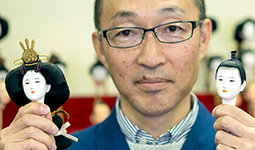Home > Highlighting JAPAN > Highlighting Japan March 2017 > Traditional Crafts
Highlighting JAPAN


Doll Royalty
The dolls crafted in the Iwatsuki district of Saitama are held to be the most refined in all Japan.
White felt glove on his left hand, felt finger cot covering the ring finger of his right, Hiroshi Omamiuda gently grips the head between thumb and forefinger, and with controlled flicks of the brush fashions a hairstyle fit for an empress.
As he continues his work, the facial features become almost eerily life-like, which is apt considering the Chinese characters for his subject, “ningyo,” the word for “doll” in Japanese, literally mean “human form.”
“The most difficult feature to create is the eyebrows,” says Omamiuda, 50, who has been creating Iwatsuki ningyo dolls for the best part of three decades. “Get it slightly wrong and you can end up with something that looks like a bit of a blockhead.”
Such features would be unfitting of Iwatsuki ningyo, which first came into being during the Edo period (1603–1867) and are regarded in Japan as doll royalty.
This is particularly evident during celebrations such as the Hina Matsuri (Doll Festival, also known as Girls Day) on March 3, when numerous dolls can be seen arranged on multi-tiered platforms, with the “Dairi-bina” (emperor and empress) dolls at the top and their servants, musicians, bodyguards and so on on the lower tiers.
Their peerless quality is evident at Omamiuda’s workshop, Taisei Ningyo, which was started by his father in the Iwatsuki district of Saitama seventy years ago.
The attention to detail here among the team of artisans is astounding, each charged with different parts of the production process of what is considered to be the most important part of the doll’s form.
Inside the workshop, straw baskets are stacked with the heads of the dolls, the part of the traditional dolls that are said to reveal most clearly the skill level of the artisans who created it.
Other parts of the dolls, from the ornate kimono to the wide range of accessories, are the product of other specialist artisans, but those such as Omamiuda who make the heads face a painstakingly crucial process.
Traditionally, the head of the doll was molded from a putty-like paste made from powdered paulownia bark mixed with paste from wheat starch, though in Omamiuda’s time most are made using a silicon mold filled with sekko – a kind of plaster.
This is where the artisan earns his crust, applying layer after layer of an opaque white pigment called gofun, which is normally made from pulverized clam and oyster shells and mixed with nikawa glue.
Around six layers of a coarser gofun is applied before a much finer pigment, with a pearl-like luster, is applied, according to Omamiuda. “This is like applying a woman’s foundation,” he says. “By applying the layers of pigment we are able to perform relief work to create the shape of the nose and mouth. We finish off by painting the eyebrows, lips, blusher on the cheeks, and so on. It’s just like applying a woman’s makeup.”
Other artisans at Taisei are charged with applying the hair – made from ultra-fine strands of silk – and tiara-like ornamental headwear.
Altogether there are ten craftsmen operating at his workshop – just a fraction of the total who are involved in doll production in Iwatsuki.
“There are around 500 craftsmen in Iwatsuki and more than 3,000 employees involved in the production of dolls,” says Omamiuda. When his father started out in the 1950s, many more people were employed in the industry. “Apparently there were 300 member companies of the Iwatsuki Doll Association solely dedicated to making the head part,” says Omamiuda.
Omamiuda’s own interest in becoming a doll craftsman began at a young age, when he would playfully color in the faces of dolls that had not been placed on the market. As a junior high school student he had made up his mind to follow in his father’s footsteps, but following the sudden passing of his father when Omamiuda was still only 17, he learned the trade from other Iwatsuki craftsmen during the day, and set about perfecting his craft upon returning home at night.
Even today, however, he does not feel he has gained the status of a fully fledged craftsman. “To be able to create all of the required components, and to make them with the requisite skills to make top-notch dolls takes decades,” he says. “I don’t feel I am there yet.”
© 2009 Cabinet Office, Government of Japan









